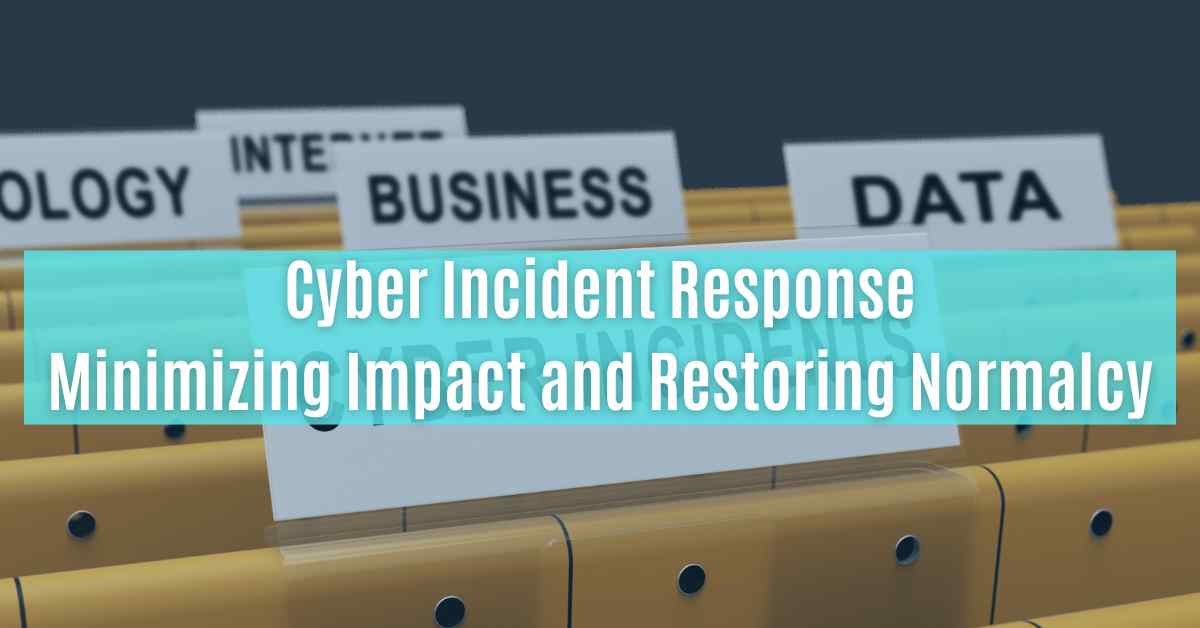Organizations in the digital age are constantly at risk from cyber incidents, which can impair operations, compromise sensitive data, and harm reputations.
A wide range of cyber dangers, including data breaches, ransomware attacks, and distributed denial of service (DDoS) attacks, have become more prevalent due to the quick development of technology.
Organizations must have a robust cyber incident response plan to reduce cyber incidents’ effects and restore normalcy.
A thorough cyber incident response strategy enables organizations to respond to and recover from cyber incidents quickly and effectively. It entails a coordinated effort to create communication channels, assign roles and duties, implement incident mitigation measures, and restore systems and data integrity.
Organizations can successfully contain the crisis, reduce possible harm, safeguard sensitive information, and resume normal operations by adhering to a well-defined incident response strategy.
The main elements of a cyber incident response plan will be discussed in this article, including incident detection and categorization, incident containment and eradication, system recovery and forensics investigation, communication, and reporting.
Organizations may better prepare for and respond to possible cyber attacks, minimizing their damage and guaranteeing a rapid return to normal operations by understanding the significance of a proactive cyber incident response strategy.
Table of Contents
How to prepare for Cyber Incidents?

In today’s digital environment, responding to cyber incidents seriously threatens businesses and organizations. Effective strategies must be in place to react successfully to a cyber incident response. This entails creating an incident response team, creating a thorough incident response strategy, and holding regular drills and simulations.
A comprehensive incident response plan must guide the organization’s reaction and recovery efforts. In the event of a cyber incident, this plan describes the procedures to be followed, the chain of command, and the communication protocols.
It should be updated frequently to reflect the evolving threat landscape and changes to the organization’s IT infrastructure. This strategy guarantees a planned and well-coordinated reaction to lessen the effects of a cyber incident.
A reaction team must be developed to manage cyber occurrences successfully. This team should comprise people with various skill sets, such as communication experts, lawyers, and IT professionals.
They should have the technological know-how required to look into, contain, and repair any possible damage and be well-versed in responding to cyber crises. The cyber incident response team has to be fully staffed and have access to the resources and equipment they need to do their jobs well.
The incident response team must undergo regular training and simulations to ensure readiness. Cybersecurity threats constantly change, and bad actors are continually developing new methods.
The incident response team can stay current on cybercriminals’ latest dangers and tactics by holding regular training sessions. The unit can practice its response tactics and find any holes or vulnerabilities in the Cyber Incident Response plan by simulating a variety of cyber occurrences.
How to detect and analyze cyber incidents?

Cyber incident response is a crucial component of contemporary cybersecurity, which entails several actions meant to identify, assess, and reduce possible cyber risks. This procedure is essential for guaranteeing early cyber incident response and detection, reducing their impact on businesses and people.
The first phases in a cyber incident response are early detection and incident triage. Organizations use a variety of monitoring strategies and technologies to spot any suspicious behaviour or anomalies in their systems or network.
Thanks to this proactive strategy, security professionals can respond quickly and contain the situation before it worsens.
After an incident is discovered, a comprehensive incident analysis is crucial. To do this, pertinent data must be gathered and examined to ascertain the occurrence’s kind, cause, and scope.
Understanding the attacker’s tactics, methods, and procedures (TTPs) through this study can help mitigate the damage and prevent future events of the same type of incident.
Another critical component of cyber incident response is determining the extent and impact of the occurrence. This comprises determining the probable harm caused and the compromised sensitive information.
Organizations can efficiently allocate resources, prioritize response efforts, and put the proper countermeasures in place to lessen the effects of an incident by analyzing its scale and impact.
How to contain and mitigate the incident?

An essential step in the cyber incident response procedure is containing and mitigating a cyber incident. It’s critical to act quickly when an issue has been identified and investigated to stop its spread and lessen its impact on the systems and data of an organization.
Isolating affected systems is the first stage in containing a cyber incident response. To stop the attacker from accessing other systems entails severing infected devices or networks from the rest of the infrastructure. Limiting the attacker’s lateral movement and averting additional damage can be accomplished by isolating the damaged systems.
Organizations must also implement temporary or long-term countermeasures to contain the crisis efficiently. Implementing firewall rules, upgrading access controls, or deactivating particular services or accounts are some of these countermeasures. Organizations can restrict an attacker’s ability to exploit flaws or obtain unauthorized access to systems by putting these safeguards in place.
How to restore normalcy after the cyber incident?

Restoring normalcy is one of the most critical stages of the cyber incident response procedure. Organizations must concentrate on restoring impacted systems and data to their typical functioning state after containing and minimizing the crisis.
Bringing damaged systems back online is the first step in getting things back to normal. This includes removing any harmful code or backdoors, checking the validity of system files, and adjusting settings to ensure they comply with corporate security guidelines.
Reinstalling software programs, retrieving data from backups, or starting again with a compromised PC may all be necessary throughout this procedure.
Completing a post-incident study and analysis is crucial when the systems and data have been recovered. This analysis assists in determining the incident’s underlying cause, assessing the success of the response, and assessing any holes or vulnerabilities in the current security procedures.
Organizations can enhance their incident response capabilities and avoid repeat events in the future by comprehending the lessons learned from the occurrence.
It is critical to update the incident response strategy and procedures in light of the findings of the post-event analysis. This entails adopting any fresh information, recommended methods, or additional security precautions found through the research.
Organizations may ensure they are better equipped to address future events and lessen their systems and data damage by revising their cyber incident response plans.
How to communicate and report while facing cyber incidents?

The cyber incident response procedure requires effective reporting and communication. They help keep communication open, promote teamwork, and ensure the proper steps are followed to resolve the issue.
When a cyber event occurs, it’s crucial to alert internal stakeholders like senior management, IT teams, legal departments, and human resources and work with them.
Open channels of communication make it possible for essential decision-makers to be aware of the crisis, enabling them to offer the required support and appropriate funds for reaction and recovery operations.
Internal stakeholders must work together effectively for a coordinated reaction and decision-making addressing the situation.
Equally crucial is transparency in communications with other parties. Companies should develop open lines of communication with their clients, partners, suppliers, and other critical external parties. Honest, timely communication helps control expectations, ease worries, and uphold trust. Updates on the occurrence, its consequences, and the actions to address it must be precise and concise.
It can be required in some circumstances to report the incident to the proper authorities, like law enforcement or regulatory entities. This usually refers to situations where there have been data breaches, thefts of private information, or attacks that have disregarded regulations.
By informing the proper authorities about the occurrence, you can help launch the necessary investigations, legal and enforcement actions. Additionally, it supports group initiatives to reduce cybercrime and enhance cybersecurity procedures.
Continuous Improvement

Continuous development is a crucial component of cyber incident response because the threat landscape and attack methods are constantly changing. Organizations must actively gather metrics and data to evaluate their incident response skills and pinpoint development opportunities.
Organizations can assess the effectiveness of their incident response processes by gathering metrics and data. Metrics like mean time to detect and respond to issues fall under this category.
Moreover, organizations can discover bottlenecks or inefficiencies in their response processes by analyzing these indicators and then making changes to improve the efficiency of their incident response operations.
Cyber Incident Response protocols must be continuously improved and updated to be effective. This entails periodically reviewing current procedures, looking for holes or weaknesses, and making the appropriate adjustments. Tabletop simulations or incident response drills can help organizations evaluate and validate response protocols and pinpoint areas that require improvement or more training.
Keeping up with new risks is essential for developing a successful incident response plan. New attack methods are always being created, and cybersecurity dangers are constantly changing.
Organizations should proactively change their response methods to address evolving threats by keeping up with the most recent threat intelligence and industry trends. This may entail changing security rules, tweaking detection systems, or altering threat models to counter new attack vectors.
Organizations should also collaborate and share information with other businesses in the same sector, cybersecurity forums, and threat intelligence sources. Participating in these communities enables organizations to learn from others’ experiences, get insightful information, and apply best practices to their incident response processes.
The incident response team’s continual training and skill development should be a part of continuous improvement in cyber incident response. This makes it possible to guarantee that team members stay updated with the most recent technology, tools, and incident response strategies. Regular training sessions, workshops, and certifications offer chances to improve knowledge and develop skills.
Conclusion
A well-prepared cyber incident response strategy is essential in today’s digital environment. The creation and upkeep of efficient crisis response skills must be prioritized by organizations. This covers prevention, early identification, analysis, containment, mitigation, resumption of regular operations, and ongoing improvement.
Organizations may lessen the effects of cyber disasters, safeguard their systems and data, and quickly resume normal operations by having a plan. Additionally, a swift return to normalcy is necessary to limit financial losses, preserve consumer confidence, and prevent potential reputational harm.
Organizations must have a robust Cyber Incident Response plan to combat and mitigate the constantly changing cyber threats effectively.
FAQs
1. What is the purpose of cyber incident response?
Ans. The goal of cyber incident response is to identify, assess, contain, and recover from cyber threats or assaults to reduce the damage they have on the systems and data of an organization.
2. What makes having an incident response plan in place essential?
Ans. An incident response plan offers an organized method for responding to incidents that minimize downtime, protects data, and upholds consumer confidence.
3. How many businesses lessen the effects of a cyber incident?
Ans. Organizations can prevent further damage and restrict the spread of an incident by quickly identifying and limiting it, which will help them save money and maintain their reputation.
4. How do you return to normal following a cyber incident?
Ans. Bringing damaged systems back online, performing a post-event study, revising incident response guidelines, and maintaining efficient communication with stakeholders are all part of restoring normalcy.
5. When should a plan for incident response be put into action?
Ans. Once a potential problem is recognized, an incident response plan should be activated to begin an organized and coordinated response.
6. How can businesses ensure communications are clear during a cyber incident?
Ans. Organizations should develop open communication channels internally and publicly to preserve confidence and manage expectations. This will allow them to deliver timely and transparent updates to stakeholders.
7. What part does cooperation play in responding to cyber incidents?
Ans. Collaboration between internal teams, external stakeholders, and specialists makes sharing information easier, coordinating responses, and taking advantage of the combined wisdom and resources available.
8. How can businesses strengthen their capacity to respond to cyber incidents?
Ans. By gathering and evaluating data, we continually enhance response techniques, keep abreast of new dangers, and invest in ongoing training and skill development.
9. At what point after a cyber incident should authorities be notified?
Ans. Following applicable laws or regulations, authorities must be alerted when incidents involving data breaches, the theft of sensitive information, or violations of legal or compliance requirements occur.
10. What are recommended practices for successfully reacting to a cyber incident?
Ans. Best practices include maintaining up-to-date backups, having a well-documented incident response plan, regularly practising incident response, and utilizing threat intelligence to improve detection and response capabilities.












